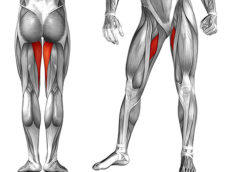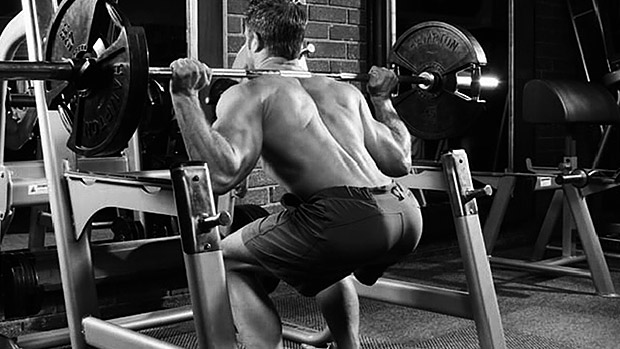What do you get when you cross a bodybuilder with a martial artist? Answer: A person you want on your side in a bar fight! Charles Staley is that and much more. Charles is one of those rare teachers who has a special insight into the plight of the common man.
Starting out at what some would call a "genetically cursed" 140 pounds, he gradually built himself up through diligent studying, experimentation, and sheer hard work to his current 205 pounds. Along the way, he's been a Master's level discus competitor, a martial arts instructor and competitor, as well as a successful Olympic weightlifting coach. Currently, Staley supervises the training of several elite athletes in a variety of sports, including track and field, jui jitsu, weightlifting, powerlifting, and judo.
For over eight years he's developed policies and course content for the International Sports Sciences Association (ISSA) and teaches several certification seminars a year. Teaching others is his passion, and to date he's had over 150 articles published in a variety of bodybuilding and martial arts magazines. Mr. Staley is the author of "The Science of Martial Arts Training," a book on physical preparation methods for combat athletes. Charles has some unique theories on training techniques for optimum performance and muscular growth, and that was the focus of much of this interview.
T: Do you find that a lot of people at seminars "size you up," associating a muscular physique with credibility as a strength coach? If so, what may be wrong with this assumption?
CS: Well, with me, there's not much to size up really. I guess I weigh about 205 at 6'2". So there's not much about me that other people find threatening, I guess. But it's all in the approach as well. If I walk into a seminar saying, "Okay, shut up, the master has arrived," then people would obviously be looking for a way to shoot me down. But I take a much more low key approach and try to let the information speak for itself.
I actually think there's often an inverse correlation between physique and knowledge. (One exception to this rule is Poliquin, who's knowledgeable and big.) Very often if you're a freak, then you never had to think about things as much as someone like me who had to struggle for every pound of muscle. This isn't a slight against anyone. For example, I happen to be a good writer, but you wouldn't want me to be your writing teacher. I've never even thought about it. It just happens and I have no idea why. So it's a mistake to judge a strength coach's ability by his or her physique. Of course, that doesn't mean you should seek out a fat slob!
T: True! What else is wrong with judging the book by its cover, so to speak?
CS: Well, you also have to look at where someone has come from. In my own case, despite the fact that I look more like a tennis player than a bodybuilder, I weighed about 140 at age 20 and about 155 at age 30. So I've made a lot of progress on a personal level. It's just that I started out looking like Jerry Sienfeld's anorexic distance runner brother!
T: Good point there. Certain strength coaches, such as Bill Starr, often advocate the quick Olympic lifts as a means of adding mass. Do you feel that bodybuilders should incorporate the quick lifts if muscle mass is their only concern, or is the time under tension too brief to have any impact on hypertrophy?
CS: Well, there are a few things to consider with respect to this question. First, in order to provoke a training response, you need both magnitude of load as well as extent, what Ian King would call time under tension. So, with the Olympic lifts, you have tremendous magnitude, but very minimal time under tension. This doesn't seem to hurt successful Olympic lifters (who have superb muscular development); however, it's a chicken-and-egg type of question. Does the method produce the muscles, or is the fact that the lifter is genetically gifted that makes the training work?
T: What do you think?
CS: It's probably a little of both. To answer your question, the Olympic lifts and their variations can be very useful tools for bodybuilders, particularly on the neural front. As an illustration, I've watched very large bodybuilders struggle to clean 135 pounds. They have no concept of acceleration because they tend to always train in a very slow, deliberate fashion, which makes no sense to me at all. So when you tell them to "jump" with the weight, their eyes start to go buggy like they've seen a UFO or something. It's just a very foreign concept to many of them.
T: I've often noticed that sprinters, on the average, have superior hamstring development compared to bodybuilders. Should bodybuilders be adding sprints to their leg training regimens or are they already doing all they can with leg curls and stiff-legged deadlifts?
CS: I like sprints and other ballistic activities for bodybuilders for the same reason I like Olympic lifts – neural drive. If I weigh 200 pounds and do a slow rep with 400 in the squat, I'm probably putting just a nudge more than 600 pounds of force through the floor, maybe 700 to 800 pounds just to give it the benefit of the doubt. But if I stand up on a bench and jump down onto my bathroom scale, I'm going to register far more force than that. This is the beauty of all forms of accelerative training – extremely high levels of tension in the involved muscles. The only caution would be that bodybuilders tend to weigh a lot by definition, so you've really got to work into it gradually.
T: Let's talk martial arts. Would you consider excessive muscle mass a hindrance to speed and/or flexibility, or would the added strength of such a heavily muscled man be an advantage?
CS: It depends on the art or discipline. If you're a point fighter or fencer for example, it helps to weigh as little as possible (within reason) because you've got to move your own body through space to cross that gap between you and your opponent. But for NHB (no-holds barred) type events, many of the most successful competitors are very heavily muscled individuals. In these disciplines the more you weigh, the harder it is for your opponent to move you and the easier it is for you to move him.
I would also have to say, however, that it depends on your individual fighting style and strategy. If you weigh165 pounds on your best day and you typically fight guys who outweigh you by 50 to 70 pounds, your strategy is going to be to take him into deep water (i.e. try to make the fight extend into late rounds) in order to tire him out. In a case like this, there's no advantage to gaining 10 pounds of muscle, because then you're still outweighed by 40 to 60 pounds. Now your endurance is worse because you have 10 extra pounds of muscle to feed!
Hypertrophy is generally not a hindrance to speed; look at Ben Johnson. It shouldn't affect flexibility either; just take a look at Flex Wheeler.
T: When you're examining the top martial artists, would you say that these men are genetic freaks in terms of power and speed, or have most of them had to work extremely hard to develop these traits?
CS: Again, I'd have to say both. You have to be a freak, then you have to work your tail off. If either component is missing, it just ain't gonna happen. By the way, when you say genetics, it isn't simply a matter of having a great assortment of motor qualities, but also being born with a body that can withstand the rigors of prolonged and harsh training. You can be the fastest-twitch person on the planet, with great levers, hormones, and so on, but if your body can't hold up, you'll never get anywhere.
T: Bruce Lee was known for his diligent weight training. Do you think you could have worked with him to make him even better than he was?
CS: Oh jeez, why don't you load up a good question for me, eh?! Look, if you examine what he purportedly did in his training, on the one hand, he was way ahead of his time. But on the other hand, he did a lot of things that seem silly by today's standards, like drinking cow's blood, for example. So, yes, I'm sure that I could have improved his performance ability, but so could any reasonably talented strength coach.
T: You believe that getting stronger is a direct precursor to muscular hypertrophy. However, there comes a point in most lifter's careers where they will cease to gain any further strength. How could an individual at this stage hope to continue growing?
CS: I have a theory on this, but you won't find it on Medline! If you think back to your early days in lifting, you might recall that, at the beginning, your 1RMs were always going up like gangbusters. So typically, lifters will lift heavy, stressing the intensity component of the training load. Then, progress starts to stall after a few years, and it becomes harder and harder to realize new PRs in your major lifts like you could at the beginning. So you begin to stress the volume component, doing gradually more and more sets and reps at given intensity ranges. After a few more years, you reach another plateau, and most people never get past this point.
T: So how does one bust through that plateau?
CS: My theory is that the "last frontier" is to increase training density, or the work-to-rest ratio. In other words, if Monday is back and tricep day, you repeat the exact same workout four times in a row with the only difference being that you seek to complete each successive workout in less and less time. I've found that this approach yields continued results for a lot of people who have been training for years, but who've been plateaued for a long time.
T: Okay, you just mentioned that increasing volume is an important element at inducing hypertrophy. I hate to sound like Mike Mentzer, but at what level of volume would there come a point of diminishing returns? Fifty sets in a workout? A hundred?
CS: There's no one answer, of course. It depends on age, training age, health status, past training habits, and to what degree you're taking sets to failure. For example, if you perform multiple sets with a submaximal weight, emphasizing acceleration, you can do many more sets than if you're doing sets that reach failure between 8 to 12 reps.
In the former scenario, between 20 to 40 sets can be done. In the latter case, between 12 to 20 sets per workout would be the norm. In both cases, the workout would take less than an hour, after warm-ups. To me, if you can do the workout in an hour, you probably didn't do too many sets. But that doesn't mean you did enough.
It's all in context. For example, last week I was feeling uninspired, and just to shake things up, I decided to do 100 pull-ups in 60 minutes, with no particular set/rep format. So I did 50 sets of 2 reps and called it a day. That's not too many sets because I only had one exercise on the menu.
T: Do you think that Mentzer actually gets all the success with his clients that he claims he does? Do you also believe, as he does, that some individuals have such horrible "recovery genetics" that they can only tolerate something along the lines of five sets per workout, once every seven to ten days?
CS: I have no idea really, but five sets per workout? Maybe for some people, some of the time, but as a rule, no. I tend to think that people are more alike than they are different. However, Jerry Telle put me through a biceps workout once that paralyzed me in one set. It consisted of a prolonged drop set that lasted like five minutes!
So we need to be careful about hard and fast rules. It really depends on what you're doing, how hard you're able to work, and so on. But if Mentzer says one set of 12, I'd counter that by saying that four sets of three at the same weight will be more effective.
T: Interesting! Can you elaborate on that?
CS: In other words, you'll accumulate much less fatigue doing triples, which allows you to accelerate the weight. The acceleration results in more tension, which leads to better motor unit recruitment, which leads to more hypertrophy of fast fibers. The training load (volume and intensity) is identical, so it's hard to argue that somehow it would be less effective.
T: Oh, I'm sure Mentzer could find a way! Is cardiovascular exercise, in your opinion, the best way to lose body fat? If so, what types and intensity?
CS: No, it's not. The emphasis should be on intensive resistance training and nutrition. I think it's been shown fairly clearly that true aerobic exercise burns relatively few calories as compared to more intensive exercise. However, a measured amount of aerobic work can accelerate recovery. I'd recommend maybe 20 or 30 minutes, two or three times a week.
T: Your concept of "stabilizer failure" makes a whole lot of sense. You contend that because the smaller stabilizing muscles fatigue before the larger muscle groups, it's prudent to perform dumbbell movements first, barbell movements later in the workout, and save machines for the end of the session. That seems like common sense, so why haven't more trainers adopted it?
CS: Well, I think Paul Chek should be given credit for this idea, not me. But there's a logic to it, certainly. It really just boils down to the age-old premise of doing the most neurologically difficult work first when you're still fresh, then proceeding to less demanding tasks. So if you plan on testing your 1RM on a barbell bench press, then do that before dumbbells, because it's more neurologically demanding. Also, the dumbbell work will benefit from the fact that you jacked up your nervous system with the barbell. I would look at stabilizer involvement as a component of neural demand, but not the only component.
T: Charles, some personal trainers and personal training certification organizations have given the profession a bad name. How is ISSA different from these other organizations and what's it doing to upgrade the image of personal training?
CS: For starters, ISSA has never said that certification is the only step in your preparation. It's simply one step along the way. We encourage people to do everything they can to enhance their skills. This includes taking other certifications as well. The ISSA also offers around-the-clock technical support (via an 800 line and e-mail, as well as interactive web technology) for their members. Their staff is superb. It's not manned by minimum wage school kids with a script, but by skilled individuals who are intense and passionate about training and nutrition. Anyone thinking about certification should certainly investigate ISSA before making any decisions.
T: Thank you so much for an excellent interview.
CS: You're very welcome, Ron.
Whether you're a performance athlete, a bodybuilder, or a martial artist, Charles Staley has a lot to offer. Maybe we can twist his arm and get him to pen a few articles for Testosterone. Then again, if we tried to twist his arm he'd probably kick us in the liver and toss us to the floor like an extra in a Jet Li movie. On second thought, maybe we'll just ask him nicely.




